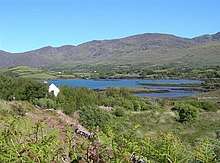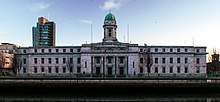South-West Region, Ireland
The South-West Region (coded IE053)[1] is a NUTS Level III statistical region of Ireland. It consists of the territory of Cork City, the regional capital, as well as the counties of Cork and Kerry. The South-West region spans 12,161 km2, roughly 16% of the total area of the state and according to the 2016 census has a population of 689,750.[2]

Prior to 2014, the region was governed by the South-West Regional Assembly. Statutory instrument No. 573/2014 abolished that assembly.[3][4] Since that date, the association between Regional Assemblies and NUTS regions has ceased. The NUTS regions are used for statistical reporting to Eurostat, while the Regional Assemblies are responsible for planning at a local government level.
The South-West Region benefits from a mild climate and has a very scenic environment,[2] which includes features such as MacGillycuddy's Reeks (the highest mountain range in Ireland), the Dingle Peninsula, Mizen Head and the Iveragh Peninsula along with numerous small islands.
South-West Regional Authority
The South-West Region was administered by the South-West Regional Authority, which consisted of 24 elected representatives, including the region's representative on the EU Committee of the Regions. These representatives met once a month and were nominated from the three administrative councils of the region:[2][5]
- Cork City Council (7)
- Cork County Council (9)
- Kerry County Council (8)
The Regional Authorities were dissolved in 2014 and were replaced by Regional Assemblies.[6]
Demographics

The South-West region has experienced a steady increase in its population with migration to the region due to its strong educational infrastructure, scenic beauty, mild climate, as well as its quality of life and work.[2]
According to the 2016 census, the South-West region had a population of 689,750, which constitutes 14.5% of the national population. Its population density was 52.5 persons per km2.[2] 78.6% of the south-west's population (542,196 people), reside in County Cork. The remaining 21.4% (147,554 people) live in County Kerry.
The southwest is the home of "Munster Irish", and contains a number of nationally significant Gaeltacht areas, such as Dingle, Cape Clear Island and Muskerry. 14% of Ireland's Gaeltacht population lives in Cork and Kerry. According to the 2016 Census, 43% of Kerry and 45% of Cork are able to speak Irish.
The population of the regional capital, Cork City, including its suburbs was 208,669.[2]
Economy
.jpg)
The region's economy consists of a range of multi-national companies that specialise in areas such as electronics and pharmaceuticals. The food industry also forms an important sector in the regional economy. Tourism is also a major industry in the region.[2]
According to CSO figures for 2014, the region has a GDP of €33.745 bn and a GDP per capita of €50,544.[7]
Eurostat figures for 2012 gave the region a GDP of €32.370 bn and a GDP per capita of €48,500 (second highest on the island of Ireland, second only to Dublin €57,200).[8]
The workforce of the region in 2003 was 255,800, which equated to a 95.58% employment rate with services (59.9%), industrial employment (31.2%), and agriculture (8.9%) forming the key industries.[2]
The 2016 unemployment rate for the South-West region, at 5.7%, is the lowest of any other Irish NUTS region.[9]
Transport
The South-West region contains two airports, Cork International Airport and Kerry International Airport, both of which provide a wide range of flights to locations across Europe. The region also has ferry services operating between Cork, the United Kingdom and France.[2]
Geography
_(27811503116).jpg)
Ireland's southernmost and westernmost points are located in the Southwest. Including islands Tearaght Island is the westernmost point located 12.5 km west of the Dingle Peninsula in Kerry. The southernmost point is Fastnet Rock which lies 11.3 km south of mainland County Cork. Only including mainland Ireland, Brow Head, County Cork is the southernmost point and Dunmore Head, County Kerry is the westernmost point. Ireland's twelve highest mountains are located in County Kerry. Killarney National Park in Kerry has Ireland's only native herd of Red Deer and the most extensive covering of native forest remaining in Ireland. The southwest has a total of 132,274 hectares (326,856 acres) of Forest and woodland area, larger than six different Irish counties. The area of the Southwest is 12,203 km2, roughly 14.5% of Ireland's land area which is large enough to fit the 10 smallest counties inside it and almost as large as Northern Ireland. The combined coastline of Cork and Kerry is 1,778 km including islands.
Major settlements
A list of the ten largest settlements in the southwest County capitals are included and are shown in bold.

| Rank | Town | County | Population (2016 census)[10] |
|---|---|---|---|
| 1 | Cork | Cork | 208,669 |
| 2 | Tralee | Kerry | 23,691[11] |
| 3 | Ballincollig | Cork | 18,621 |
| 4 | Carrigaline | Cork | 15,770 |
| 5 | Killarney | Kerry | 14,504 |
| 6 | Cobh | Cork | 12,800 |
| 7 | Midleton | Cork | 12,496 |
| 8 | Mallow | Cork | 12,459 |
| 9 | Youghal | Cork | 7,963 |
| 10 | Bandon | Cork | 6,957 |
Sport
The south west region is the base for several sporting teams such as professional association football teams, Cork City FC and Cobh Ramblers, who compete in the League of Ireland, Kerry GAA and Cork GAA, who compete in the All-Ireland and Munster Championship in traditional Irish sports, Gaelic Football and Hurling and American Football team, Cork Admirals. Teams also compete in rugby, cricket, hockey and various other sports.
References
- "Revision to the Irish NUTS2 and NUTS3 regions". cso.ie.
- Irish Region Office - Regions of Ireland: South-West Region Archived 2011-07-19 at the Wayback Machine
- http://www.irishstatutebook.ie/2014/en/si/0228.html
- Statutory Instrument 573/2014
- "Archived copy" (PDF). Archived from the original (PDF) on 2011-07-21. Retrieved 2010-09-17.CS1 maint: archived copy as title (link)
- http://www.irishstatutebook.ie/2014/en/si/0228.html
- "CSO statistical release, 22 March 2017 - County Incomes and Regional GDP 2014". CSO. 22 March 2017.
- "Archived copy". Archived from the original on 2014-10-06. Retrieved 2017-07-21.CS1 maint: archived copy as title (link)
- "Table 9 Persons aged 15 years and over classified by NUTS2 and NUTS3 regions and ILO Economic Status". Quarterly National Household Survey. Central Statistics Office. 21 February 2017.
- "Population Density and Area Size 2016". Central Statistics Office (Ireland). Retrieved 5 September 2018.
- "Sapmap Area - Settlements - Tralee". Census 2016. CSO. 2016. Retrieved 5 September 2018.